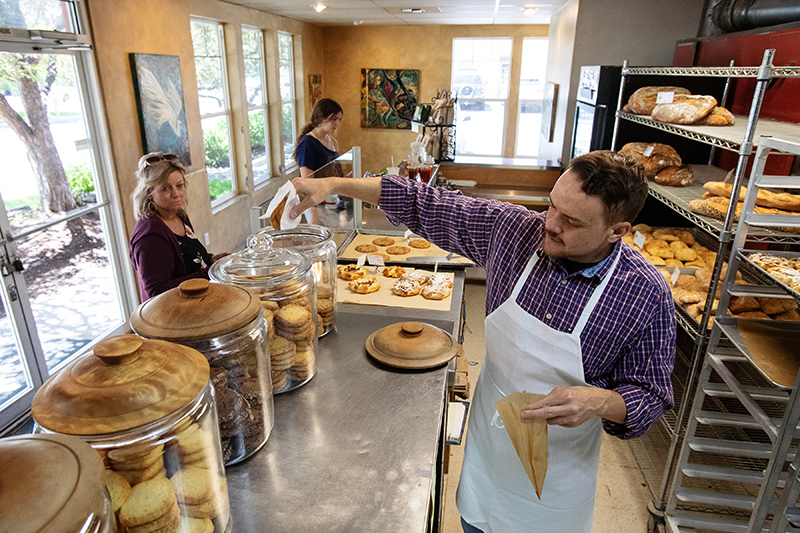Restaurant review: Kebaba
Published 12:00 am Thursday, April 19, 2018

- The Fattoush Salad with salmon, from left, the Locals Secret cocktail, Falafel and Chicken Hummous at Kebaba restaurant in Bend on April 11, 2018. (Andy Tullis/Bulletin photo)
To speak of Middle Eastern cuisine is to say a mouthful. So when a server at Kebaba, on Bend’s west side, described the restaurant’s cuisine as Turkish, he was doing the establishment a disservice.
He was partially correct, of course. But Turkey is only a small piece of this intricate culinary puzzle, which stretches more than 2,500 miles from Greece to Iran and Saudi Arabia. And each country in this eastern Mediterranean mishmash, from Lebanon to Egypt, Israel to Armenia, puts its own unique brand on the food.
No doubt, there are commonalities. Lamb and chicken are the most widely eaten meats, especially as pork is prohibited in the Islamic and Judaic religions. Wheat is milled for flatbread (pita), and its grains become bulgur and couscous. A wide variety of beans and other vegetables are integral to the diet, including chickpeas and eggplant, each of which is ground with sesame oil into a paste known as hummus (chickpeas) or baba ghanoush (eggplant).
Bend has two brick-and-mortar Middle Eastern restaurants, although the food at Joolz, in the heart of downtown, might more correctly be called “Lebanese fusion,” as it incorporates many Western ingredients and styles.
Kebaba, on Newport Avenue, is more faithful to traditional recipes. A part of the local dining scene since 2007, it has tweaked its menu and decor, but it is essentially the same restaurant it was 11 years ago.
One of Kebaba’s attractions is that it can adapt its food to suit almost any diet, from vegan to carnivore, gluten-free to paleo. It is exceptionally family-friendly, and young children are often seen dining here with their parents in early evenings.
Dinner at Kebaba
My companion and I dined here twice recently, and the selections we made at midday were decidedly better than our evening choices.
We began our dinner with a pair of vegetarian appetizers, falafel ($5) and karnabeet ($6).
My friend normally loves falafel, but not these. Balls of chickpeas, blended in-house with parsley, onion and garlic, were thickly breaded in a salty batter that tasted heavily of cumin. They were served in a thin tahini (sesame) sauce.
Karnabeet is pan-seared cauliflower served in a lemony tahini sauce, sprinkled with parsley and reddish sumac. It was no better than satisfactory.
As an entree, my companion chose a saffron prawn kebab ($16.50). Two skewers of medium-size prawns, seasoned with lemon and saffron, were grilled — a little too long, she thought — and served on rice pilaf with a house salad and a house-made lemon garlic sauce. She preferred the prawns without the sauce.
My roast lamb with hummus ($14.50) featured house-roasted leg of lamb, stewed and served on hummus with pine nuts and tahini sauce. A seasoning of za’atar, a blend of spices that features thyme, oregano and salted sesame seeds, boosted the flavor. But a round of pita, baked in-house, was very doughy.
And there was confusion in my salads. My order of a Kebaba (house) salad to accompany my entree was overlooked. When I pointed out the error to my very congenial and knowledgeable server, he immediately delivered the tabbouleh salad that I had requested in its place.
The good news was: I got to try both. The bad news was: I didn’t much like either one. The house salad was basic — lettuce, tomato, cucumber and carrot — with the noted addition of currents and a lemon vinaigrette dressing. The tabbouleh, tossed in olive oil and lemon juice, was short in parsley and mint, heavy in bulgur wheat grain. But it did combine a nice chopped mix of tomato, onion, garlic and cucumber.
Delicious lunch
When we returned several days later for lunch, we were far more impressed.
We began with a spinach pie, or spanakopita ($5.50). Unlike the Greek and Turkish version, which is wrapped in multiple layers of phyllo pastry, this was a stuffed pita bun, filled not only with spinach but also onion, garlic, pine nuts and two cheeses — feta and Greek saganaki. It was different, and excellent.
Our lunch choices were accompanied by cups of soup. My companion went with vegan curry and more vegan curry. A curried soup was made of yellow Egyptian lentils, pureed in a savory vegan stock and finished with coconut milk. She wished the bowl had been larger.
She followed the potage with a curried tempeh pita sandwich ($7.50), actually a wrap. Textured soy tempeh was tossed into a salad with cashews, raisins, celery and scallions, then rolled into a pita and finished with lettuce, carrots and a curried apricot dressing. She could not have been more pleased.
I opened with a cup of spicy tomato eggplant soup. Roasted tomato and eggplant were pureed with a dash of serrano peppers and regional spices. This was not my mother’s tomato soup, the kind I once enjoyed with a grilled-cheese sandwich.
That set the tone for my main course, a chicken shawarma ($8). Tender chicken, roasted and sliced, was wrapped in a pita with lettuce, tomato, cucumber, pickled onion and garlic sauce. I thought I was back in the eastern Mediterranean.
— John Gottberg Anderson can be reached at janderson@bendbulletin.com.
Editor’s note: This article has been corrected. In the original version, the translation of spinach pie was incorrectly stated. The correct term is spanakopita. The Bulletin regrets the error.






